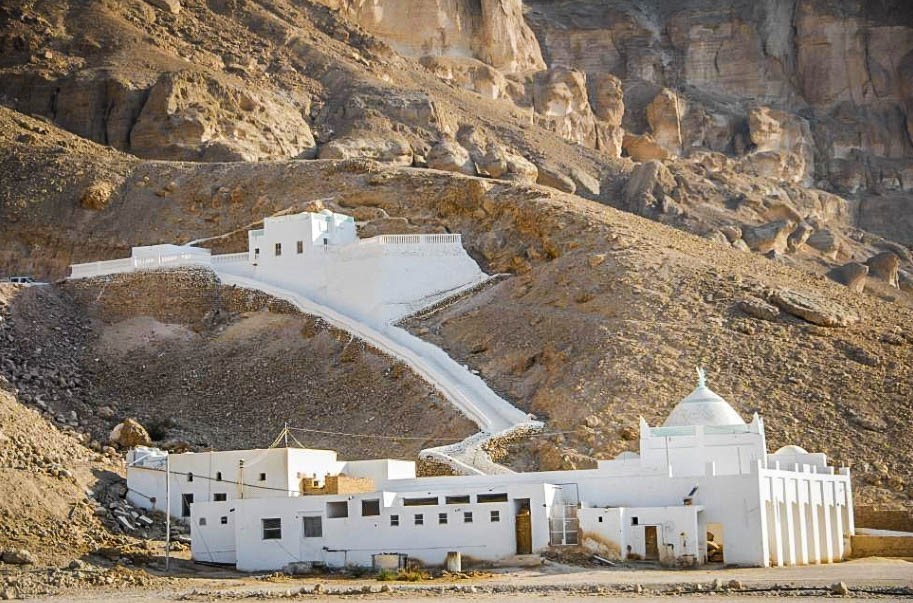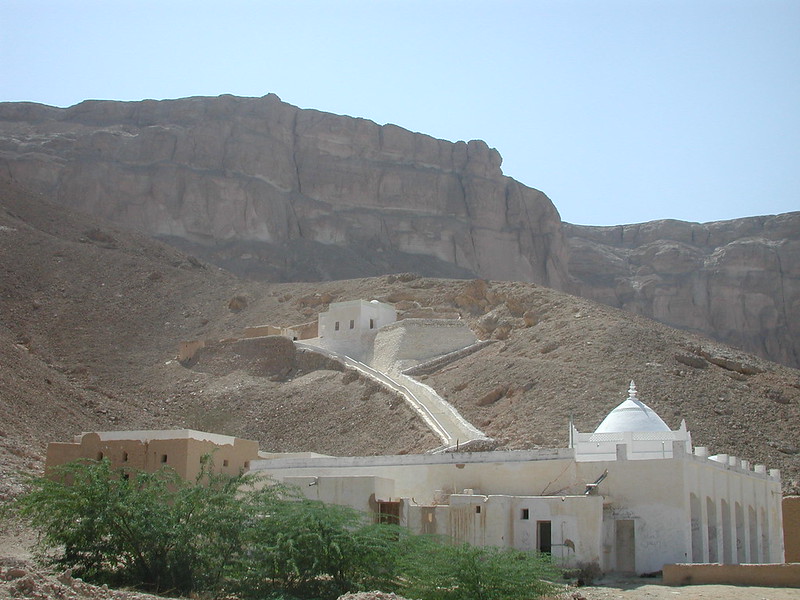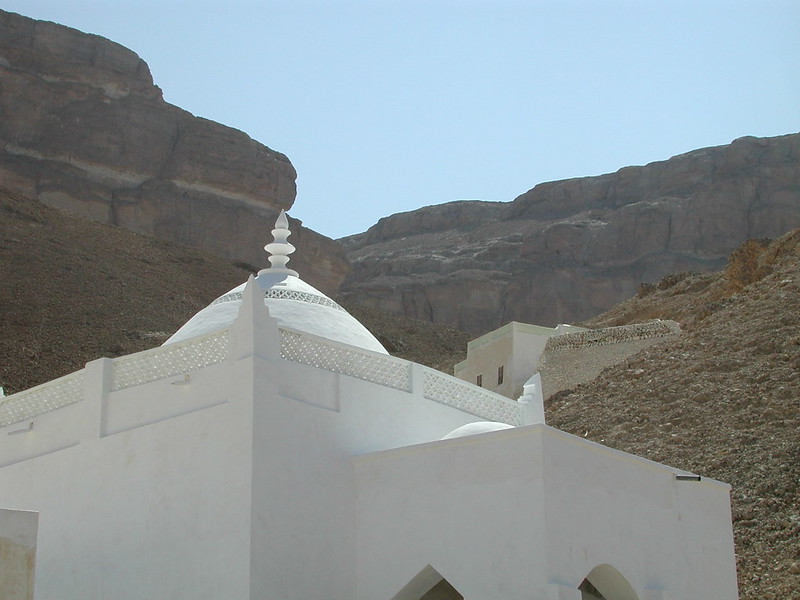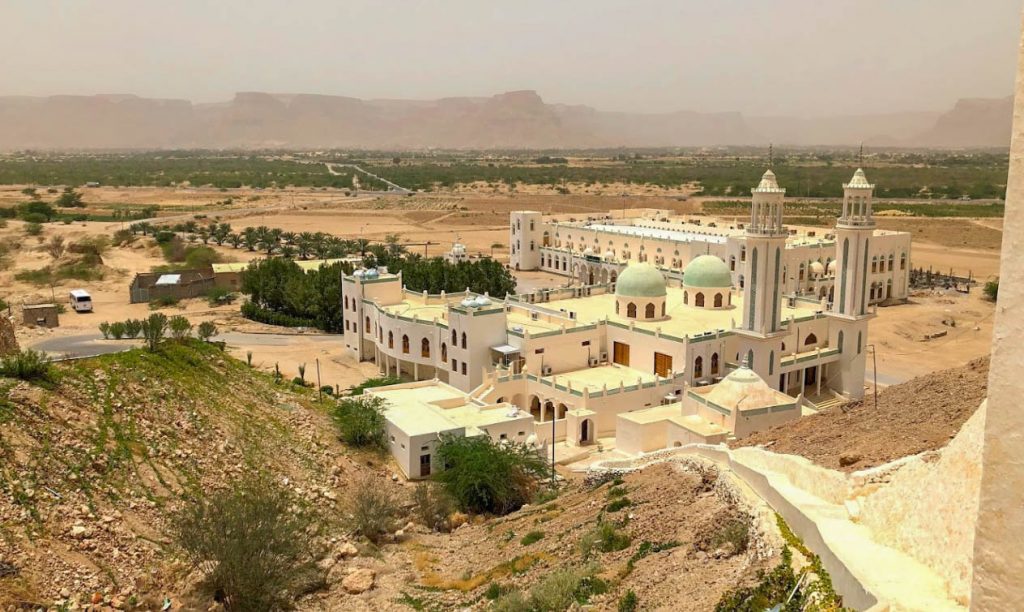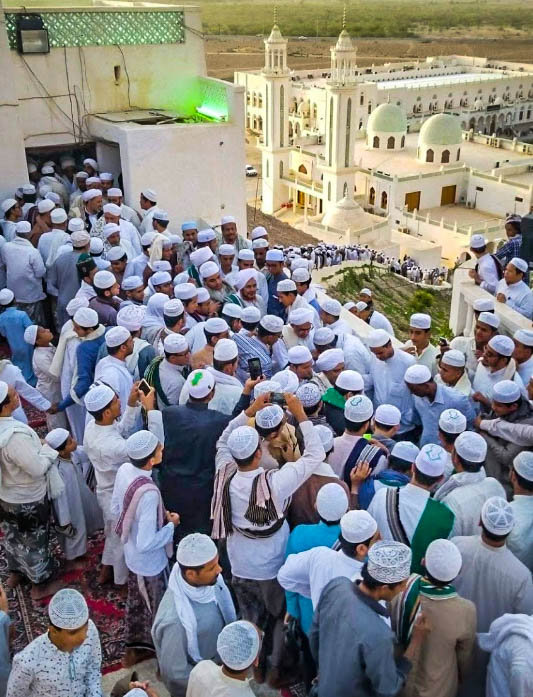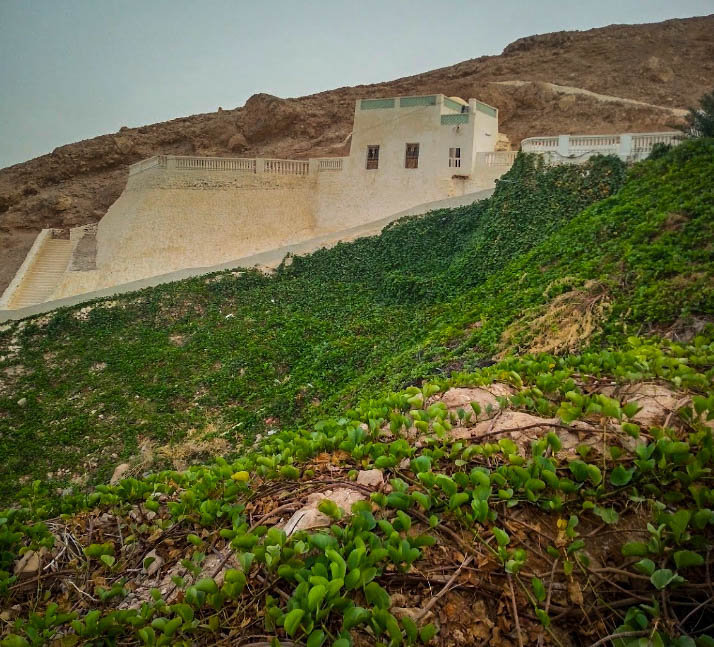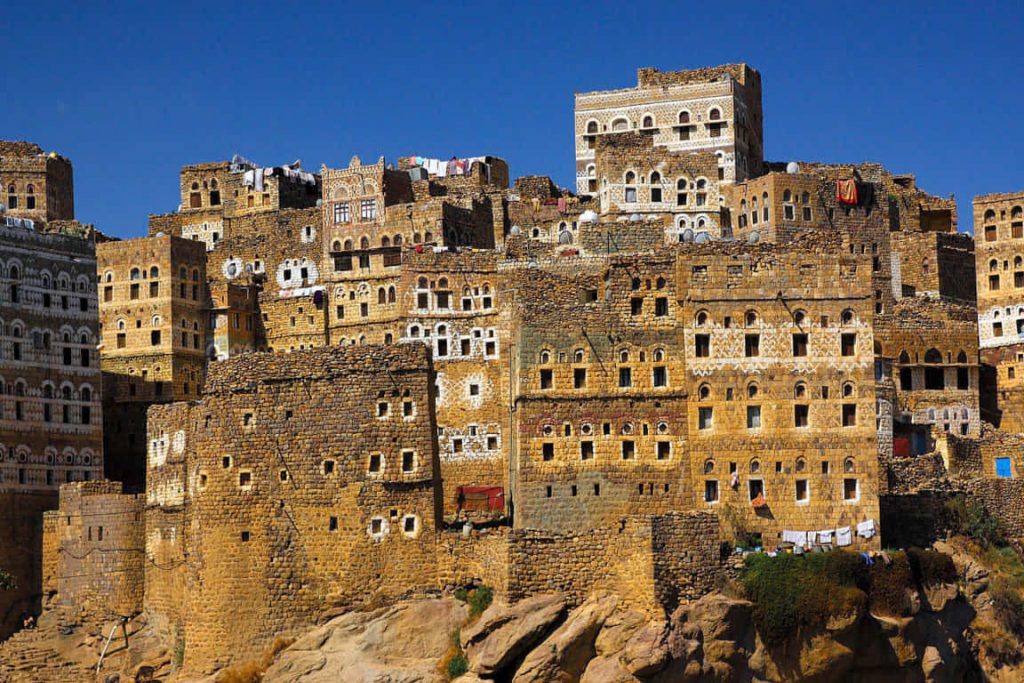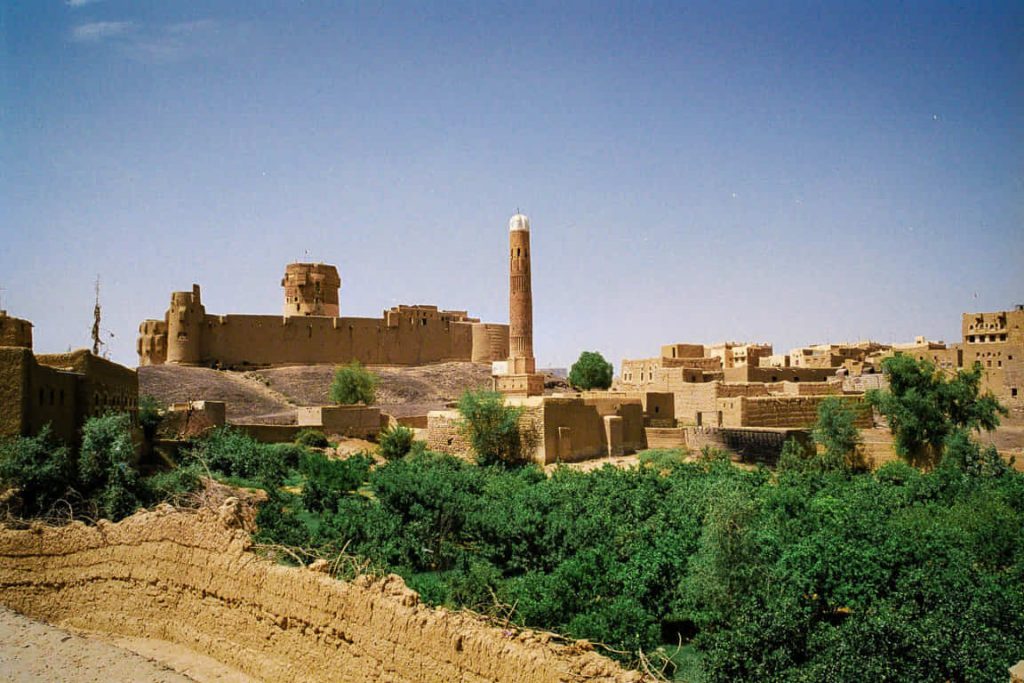Al-Husaisa – Hadramaut, Yemen
Coordinates: 15.985806, 48.871484
Nearby Places
- Tomb of Hz. Habib Ali al-Habashi رحمة الله عليه 7.73 Km SW (240°)
- Al Kathiri Palace 10.29 Km SW (244°)
- Tomb of Hz. Abdallah ibn Alawi al-Haddad رحمة الله عليه 14.99 Km NE (61°)
The Tomb of Hz. Ahmad Ibn Isa al-Muhajir رحمة الله عليه is a place of pilgrimage. It is especially popular with women pilgrims, as it is also the burial place of a sheikha – a holy woman. Hz. Ahmad Ibn Isa رحمة الله عليه was the sayyid who re-established orthodox Islam in Wadi Hadramawt about 1200 years ago. Originally from Basra in Iraq, he made the Hajj pilgrimage to Mecca and continued south to spread the Sunni orthodox branch of Islam. He was the seventh generation descendant of Hz. Ali رضي الله عنه, the Prophet Mohammed’s ﷺ cousin and son-in-law.
At ground level is a mosque and ablutions room, alongside which is the domed tomb. Steps lead up the lower slopes to another collection of tombs and graves, those of members of his family. Stuck to the inside of the tomb walls and ceiling are hundreds of little balls of thread, placed by pilgrims hoping to be blessed with good luck.
Early life & Lineage
His full name is Ahmad ibn Isa Ar-Rumi ibn Muhammad An-Naqib ibn ‘Ali al-Uraidhi ibn Ja’far al-Sadiq ibn Muhammad al-Baqir ibn Ali Zayn al-Abidin ibn al-Husain ibn Ali bin Abu Talib. According to another history, he is thought to have been born in 241 Hijrah (820 CE).
Imam Ahmad grew up under the supervision of his parents in an environment surrounded by scholars and living examples of prophetic character. He memorized the Qur’an and then mastered the sciences of the sacred law until he reached the rank mujtahid. He also had his hadith collection (Musnad) and was held in great esteem by Imam Al-Tabari (His Musnad is not to be confused with Musnad of Hz. Ahmed bin Hanbal رضي الله عنه)
Migration
Al-Imam Ahmad bin Isa is called al-Muhajir (emigrant) because he left Basra, Iraq during the Abbassid Caliphate that was headquartered in Baghdad in the year 317H (929 CE). His inner sight allowed him to witness the calamities and tribulations that would take place in Iraq. He realized the greatness of the sacred trust that he was carrying in his loins.
Ahmad bin Isa رحمة الله عليه left Basra with his wife, his son, Abdullah, (who preferred to be known as Ubaidillah) and his grandson from Ubaidillah (Basri, who was born in Basra). With them also was Sharif Muhammad bin Sulayman, the grandfather of the Ahdal family and Sharif Ahmad al-Qudaymi, the grandfather of the Qudaymi family, and a group of 70 people. He left his other three sons Muhammad, Ali and Hussein in Iraq to take care of their wealth and property.
After visiting Madinah and Mecca, He set out for Yemen in 319 H with his party and eventually reach Hadhramaut. At the same time, Ahmad al-Qudaymi settled in northern Yemen and Sharif Muhammad bin Sulayman in Tihama on the Red Sea coast. He first settled in the village of Jubayl and then Hajrayn. Next, he travelled to the village Qarat Bani Jushayr and finally settled in al-Husayyisah near Seiyun.
His descendants became known as the children of Alawi, Banu Alawi or Ba-Alawi in hadrami province; Alawi was Imam Ahmad’s grandson. Their base was mainly in Tarim and surrounding cities in Hadramawt (Badawi, 2005). The Ba’Alawi followed Shafi’i school in jurisprudence and the Ash’ari school in creed therefore within the fold of Ahlus Sunnah Wal Jammah.
Facing Kharijites and spreading the true word of Islam
Imam al-Muhajir رحمة الله عليه arrived in Hadhramaut at a time when an offshoot of the Kharijite sect called Ibadiyyah held political power and had widespread influence throughout the valley. He persevered in the spreading of Islamic truths until he almost single-handedly removed the Ibadi sect from Hadhramaut without ever taking up arms against them.
He died in 345 H or 956 CE (another version said he died in 307 H or 924 CE) in al-Husaisah, a town between Tarim and Seiyun, Hadramaut. His shrine stands on a hill and is among the first shrines that visitors to Hadramaut pay their respects to when visiting the area.
His School of thought
There is a controversy about what Madhhab followed by Ahmad bin Isa. Most ulama (Islamic scholars) have the opinion that he was a Sunni imam. Some contend that he was a Shi’a Zaydi follower.
Habib Abdurrahman bin Ubaidillah al-Saqqaf emphasized that al-Muhajir was not Sunni Shafi’i in fiqh (jurisprudence) nor Ash’arite in aqidah (theology). As Imam Ahmad bin Isa is a Mujtahid, he does not need to follow any madhhabs.
Descendants
The Sayyids from the family of Ba’ Alawi sada of Yemen trace their descent to Hz. Ahmad al-Muhajir رحمة الله عليه.
Some of the Nine Saints of Java or Wali Sanga in Indonesia in some traditions are claimed to be descendants of him as well.
Currently, descendants of Imam Ahmad through Alwi ibn Ubaidillah spread out mostly in Yemen, Africa, Southeast Asian countries (mainly in Indonesia, Malaysia, Brunei, some in Singapore, South Philippines and a few in Thailand), and South Asian countries (Pakistan and India). Some of the prominent descendants of Imam Ahmad رحمة الله عليه are Imam Muhammad al-Faqih al-Muqaddam in the 13th century, Sayyid Abu Bakr Al-Aidarus (saint) رحمة الله عليه of Tarim and Azmatkhan in India, Sunan Ampel in Indonesia in 15th century, Imam Abdullah ibn Alawi al-Haddad رحمة الله عليه in the 17th century, Raden Saleh bin Yahya (an aristocrat and an artist) in the 19th century Haidar Abu Bakr al-Attas (former prime minister of Yemen), Habib Umar bin Hafiz of Tarim, Habib Ali al-Jufri of Jeddah in 21st century. Some of his descendants in Indonesia, among others, are Sayyid Abdullah Al-Aidarus, Habib Ali Kwitang, Ali Alatas, Alwi Shihab, and Hamid Algadri.
Imam Ahmad al-Muhajir was an Imam Mujtahid, which means he is regarded as a primary source for rulings on religious matters.


